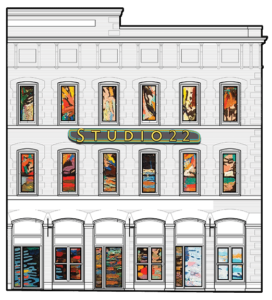by Kamille Parkinson
There are some artworks that grab you immediately when you first encounter them. There’s sometimes no rhyme or reason to it, and it might be something that is completely outside of what you think you normally like, but there it is – you’re smitten. By the same token, there is some artwork that you don’t think much of, at first glance anyway. But your eyes keep sliding back to it, again and again, though you’re not sure why. Intrigued, you return to the artwork to look at it more closely, to pay attention to it. These are the types of paintings (or other art objects) that you have to spend time with to fully appreciate, and they are often also the ones that are most worth the effort.
It’s possible that you will have this type of experience at Studio 22 on Market Square just now, with one half of a double exhibition on the walls until 13thApril. The gallery is featuring the work of the late artist Ingeborg Mohr, formerly of Howe Island, with a show titled “Signs of the Imperceptible.” Not a retrospective, the exhibition features paintings and multi-media works from a single series in Mohr’s vast compendium of work.
Mohr started out as a landscape painter but, on moving to Toronto in 1955 and discovering the work of the Painters Eleven, she turned to non-representational art that at its core is Expressive. While paint media is considered to be two-dimensional, it is also possible to build up layers of paint and/or utilize heavy applications to create depth and texture in a painting. In this way the physical media is manipulated to become expressive in its own right, with the artist choosing and blending colours to emphasize and enhance moods and emotions. This is what you will find in this series of Mohr’s paintings. In some of these works Mohr has also incorporated other media, such as coarse papers, to create additional depth and nuances.
While Mohr’s paintings are expressive in character, they are not works that grab you by the lapels and announce their intent. Rather, these are works that, predominantly dark in tone and sombre in character, wait quietly for you to discover them and what they have to offer. Through the deliberate application of colour and building up of layers, Mohr made an internal exploration of her own existence through the media of paint, with the resulting works inviting you to embark on a similar journey.
Where “Signs of the Imperceptible” is about building up layers, the other half of the exhibition at Studio 22 is, in a symbiotic twist, much about wearing them away. The exhibition “Bones of the Earth”, featuring works by LW Foden, presents a singular vision of the sea and rocks of the Georgia Straight as seen from a small cottage on Galiano Island, B.C., where Foden lived, observed, and painted for some 20 years. In works of various sizes and media we are given both monumental and intimate glimpses of time at work on seemingly eternal objects.
While we tend to think of cliffs and rocks as immutable things, Foden shows us the inexorable effects of time, tide, wind and sand on these very elemental objects. Imperceptibly, the rocks have been worn away layer by layer, endlessly scoured and sculpted to reveal not only suggestions of forms, but also (in Nature’s quirky way) the layers that went into their creation. Foden’s paintings have a soft, hazy quality to them, which adds a mysterious, somewhat otherworldly feel to his representations. The rocks appear timeless and almost primeval, while the occasional inclusion of driftwood, softer and similarly twisted and sculpted, reminds us that stones, the bones of the earth, are also subject to the effects of time.
Though the two exhibitions at Studio 22 are, on the surface, quite different, hanging them together actually works incredibly well. Both are concerned with layers – building them up in one case, and wearing them away in another – and both have a quiet, contemplative aspect to them that encourages the viewer to pause, consider, and delve into their respective calm, without any effort at all.
Bi-Line:
Kamille Parkinson holds a PhD in Art History from Queen’s University, and is the owner of Upper Canada Art Consulting (UCAC) in Kingston. The UCAC website is www.uppercanadaartconsulting.com, and you can also find UCAC on Facebook.
NOTE TO READER: This article was originally written for the regular monthly Art About Town column in the Saturday Whig Standard. For unknown reasons it has not been published yet. Due to the fact that the exhibits close on the 13th and timely publishing seems unlikely, the writer has graciously given us permission to share this piece with our subscribers.
PLEASE DO NOT COPY OR SHARE AT THIS TIME.



